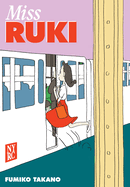
Vivaciously subversive Miss Ruki, created by Fumiko Takano and charmingly translated into English by Alexa Frank, hasn't aged since her June 1988 debut as a serialized character in Japan's weekly women's magazine Hanako. During Japan's late-1980s bubble economy, single women with disposable incomes became significant consumers, setting trends and boosting the economy.
Miss Ruki seemingly falls into this self-sufficient demographic. But from the introductory panels, she is a different level of independent: she works from home, her 1960s hairstyle shouts anachronism, fashion isn't in her vocabulary, and her attention tends toward the library's latest offerings or the post office's newest stamps. Her best (and only?) friend, Etsuko, is the too-aware stylist, attending exclusive gatherings (and dragging Ruki along in coordinated outfits) and keeping a calendar of golf sales and salon visits. Meanwhile, Ruki can split an apple with her bare hands, trips over nothing, rolls her shorts up embarrassingly high, and encourages skipping in public. Ruki effortlessly stays true to herself, all the way through December 1992, when the comic closes.
Takano "only draws manga when she feels like it," writes Frank in her contextualizing afterword. Delightfully simple cartoons fill Takano's panels, perfectly capturing dynamic Ruki's quirky, evolving expressions. Bright colors dominate, although pink and lilac are chromatic staples. Hair color inexplicably, regularly changes for both friends--orange, brown, gray, blue, green. As if to underscore Miss Ruki's timelessness, Takano appends a final page of eight panels, dated January 2003, highlighting changes, significant and not at all. Fans of Sayaka Murata and Hiromi Kawakami wishing for a whimsical comic with girl-power bite will particularly appreciate evergreen Miss Ruki. --Terry Hong

